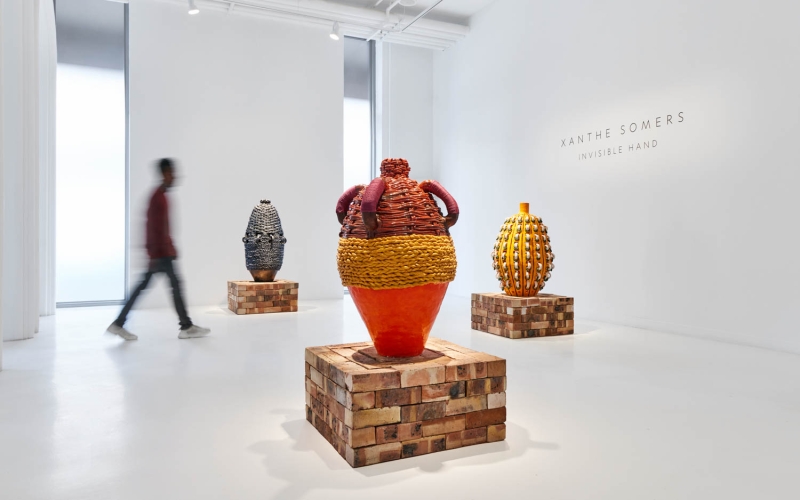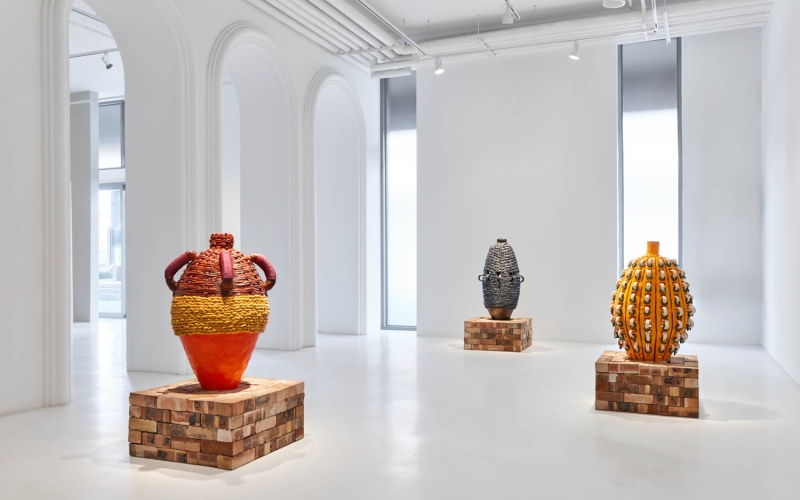Contents
- 1 Xanthe Somers Questions Post-Colonial Legacies Through Clay
- 1.1 Interior Design: Why did you choose clay as your medium of practice?
- 1.2 ID: Since you were studying prints at the University of Cape Town, how did you fall in love with clay?
- 1.3 ID: What was it like growing up in Harare, Zimbabwe, and how did that shape your artistry now?
- 1.4 ID: What has been your biggest philosophy as a ceramicist?
- 1.5 ID: There is an interesting play with ornamental details in your works. Is that to create a sense of beauty or to show Zimbabwean craftsmanship?
- 1.6 ID: You use traditional basket weaving techniques to make ceramics. How did you come to do that?
- 1.7 ID: What does your creative process look like?
- 1.8 ID: How would you describe your residency at the Southern Guild?
- 1.9 ID: What was it like creating these works for “Invisible Hand,” and how did the idea of the title come to you?
- 1.10 ID: You combine a range of colors in this exhibition, was that intentional and how many pieces did you produce in the end?
Xanthe Somers is very much inspired by politics, though not so much in the modern sense. Rather, she is inspired by the past, examining invisible colonial legacies and how they shape class afflictions, white supremacy, eco-racism, and unemployment. While she has relied heavily on clay to examine these topics, the Zimbabwean-born, London-based ceramicist uses a unique form of pottery making that is indigenous to Zimbabwe. A basket-like embellishment that makes room for holes to create strings with clay, or ropes or fabric-textured frills—her own way of drawing attention to the issues of overconsumption and cheap labor.
In her exhibition “Invisible Hand”, which opened at the Southern Guild Cape Town gallery back in August and runs until November, Somers takes viewers to Zimbabwe where she expresses her thoughts on ways people undervalue craft practices labeled as “women’s work.” She seeks solace in abolitionist and poet Lucy Larcom’s 1868 poem Weaving, and philosopher Adam Smith’s theory of the free market to further address the reasons to continue to support and embrace women’s handwork.
Interior Design chats with the ceramicist on her practice with clay, political examinations, and her recent exhibition.
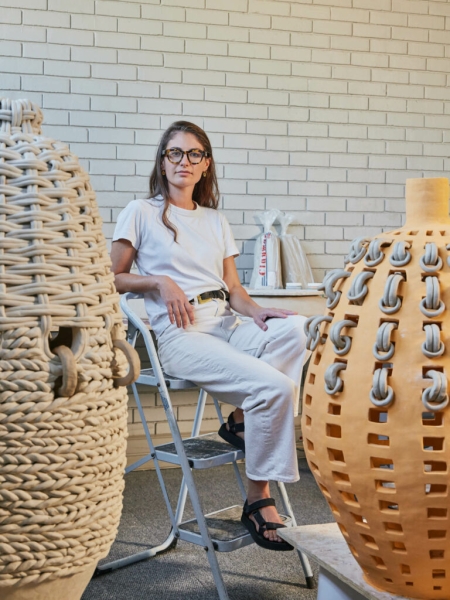
Xanthe Somers.
Xanthe Somers Questions Post-Colonial Legacies Through Clay
Interior Design: Why did you choose clay as your medium of practice?
Xanthe Somers: In 2019, I was studying for a Master of Arts in Postcolonial Culture and Global Policy at Goldsmiths, University of London, when I joined a pottery studio as a way to assuage my creative self. Playing with clay became a meditative space to think about what I was learning and, in turn, the clay started to explore those topics visually.
ID: Since you were studying prints at the University of Cape Town, how did you fall in love with clay?
XS: While I was studying for my Bachelor of Arts in Fine Art, specializing in printmaking, at the University of Cape Town, my most influential experience was the Rhodes Must Fall protest movement in 2015, which called for the examination of institutional racism within public spaces and educational frameworks. This stimulated my interest in the project of decolonization and why I went on to get my masters in Postcolonial Culture and Global Policy.
Meanwhile, I found clay outside of a school or pressurized environment and, because of that, I fell in love with it, and it became a space of uninhibited creativity: to explore, play, and make mistakes. Clay is an incredible medium that has many uses—to hold water, to hold function, to give shape, and to carry stories, which is an ability by which I am most invigorated. Throughout history, this can be traced through many objects; however, the archetypal vessel is one I always return to. Clay has the unique ability to cross the boundaries between functionality, art, class, and culture, and this makes it a vital medium to tell stories about humankind. It can be worth a few pennies in the shape of a mass-made mug or worth millions as a set of fine china. There is something poetic about taking clay from the ground we exist upon, and being the space that houses our history.
ID: What was it like growing up in Harare, Zimbabwe, and how did that shape your artistry now?
XS: I grew up in Harare, Zimbabwe, in a privileged environment—in a country riddled with the remnants of colonialism, unemployment and a huge wealth disparity. I use clay as a medium to understand my own role as a white Zimbabwean, and, more broadly, to examine white supremacy, labor practices and eco-racism within Zimbabwe, which are propagated by the Christian colonial capitalist gaze.
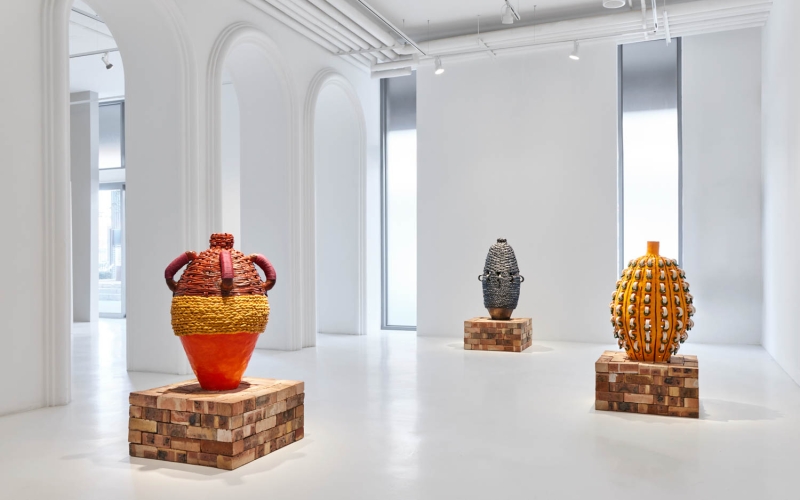
Somers’s works on display at the Southern Guild in Cape Town.
ID: What has been your biggest philosophy as a ceramicist?
XS: Working with clay is a very humbling process. Hand-building large, detailed works requires vast amounts of time spent with the clay—and with yourself. Each day, for me, is a lesson in patience.
ID: There is an interesting play with ornamental details in your works. Is that to create a sense of beauty or to show Zimbabwean craftsmanship?
XS: The concept of beauty and aesthetic values in Zimbabwe, I find, can still be Euro-centric. As humans, we make objects to serve us, but many of these utilitarian objects have the capacity to outlive us, not only projecting their use into future generations, but also the culture, ideas and aesthetic objectives which went into the process. The ornamentalism in the works I create are usually produced in a mocking or exaggerated tone, which challenges colonial ideas surrounding refinement, classism and sophistication.
While silent, the presence of these objects is far from neutral. Objects unexamined, unresearched and uncontextualized retain their ethos and the ideology of the people who built them. In Zimbabwe, that history is both conflicted and contested. The political project of independence is subtly betrayed by the subconscious context of Chesterfield sofas, ornate wrought iron gates and high tea sets.
ID: You use traditional basket weaving techniques to make ceramics. How did you come to do that?
XS: Weaving, in general, is a visceral way to speak about the domestic. The sheets we sleep on, the carpets we walk on, and the clothes on our back are all a form of woven fabric and can be extrapolated to speak more broadly about domesticity, women’s work and racialized spaces in Zimbabwe and the global South. Weaving can be used as a metaphor for social cohesion or a lack thereof, but Zimbabwean basket-weaving especially has a fraught relationship with colonial and capital projects. Binga, an area which was hugely affected by the construction of Lake Kariba, was renowned for its basketry made by the women living there. Kariba Dam was built to generate hydroelectric energy and its creation submerged vast tracts of land, altered natural habitats, affected local wildlife and displaced over 57,000 Riverine people from both sides of its banks.
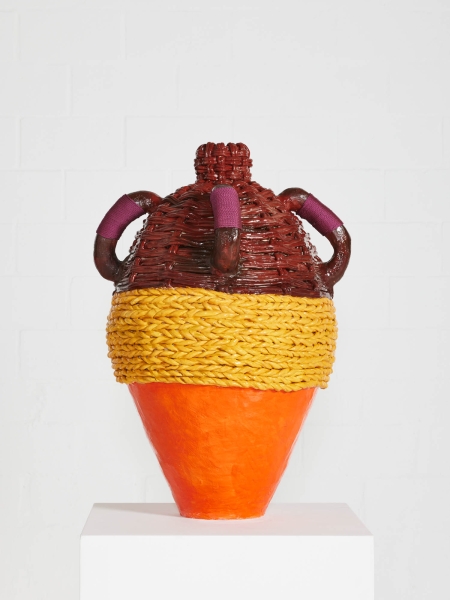
Tales Untold, 2024, glazed stoneware, nylon cord.
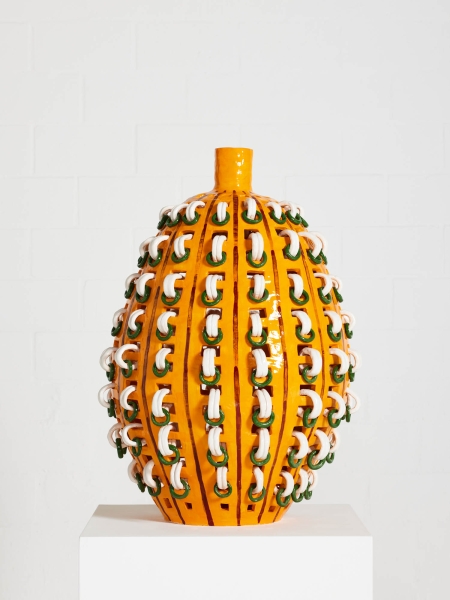
The Weary Weaver, 2024, glazed stoneware.
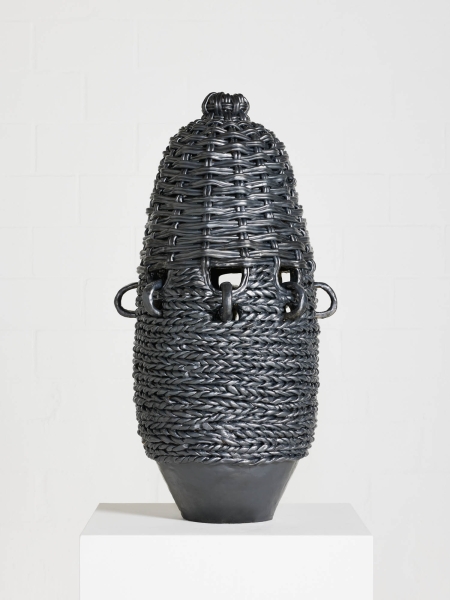
Of Woof and Woe, glazed stoneware.
ID: What does your creative process look like?
XS: The ritual of collecting clay, sculpting, and then painting is one that developed a close and visceral connection with the ceramic medium. However, the more I explored, the more I found it was a medium that stretched far further than the realm of the functional, and I now call myself a ceramic sculptor. I draw loose sketches of the shapes I want to make, but it mostly changes in the hand-building process. I try not to get too attached to pieces—as being very experimental in nature, I have to get used to cracks and breakages!
ID: How would you describe your residency at the Southern Guild?
XS: It was fantastic to go back to Cape Town since I graduated nine years ago. The eight-week residency with Southern Guild offered an amazing opportunity to reunite with old friends, make new connections and get involved with the creative community, which has exploded since I left. My focus was to work on a larger scale as the residency offered a much bigger kiln than my own, so I was pleased that I succeeded in creating the largest works I have made to date. Outside of creating, I had the opportunity to sit on a panel discussion for Art School Africa’s “Creative Conversations for Women,” enjoy studio visits with other artists to engage with contemporary South African discourse, and discuss my practice with an artist talk held at Southern Guild.
ID: What was it like creating these works for “Invisible Hand,” and how did the idea of the title come to you?
XS: When I began exploring “women’s work”—such as weaving, sewing, cleaning, caring and mending—I was inspired by Françoise Vergès’ book Making the World Clean, which asks us to contemplate why cleanliness and care have become racialized and require “invisible hands” to perform these undervalued and exploited jobs. In Zimbabwe, many homes have cleaners and gardeners who exist within this “invisible” framework: caring for children, cooking meals, and sometimes traveling for hours. This work is underpaid, undervalued, and considered unskilled.
In response to these questions around invisible care, I started to explore the material presence within the domestic realm in Zimbabwe and wrote a poem to frame the works I created during the residency.
ID: You combine a range of colors in this exhibition, was that intentional and how many pieces did you produce in the end?
XS: I produced four large works while I was there, but sadly one didn’t survive the kiln. I think humans are like bees: They’re attracted to color. I use bold colors as a way to draw attention to my sculptures, then slowly, once the viewer stays with the piece a bit longer, they will begin to see the undercurrents within the themes of the work and their questioning tones.
